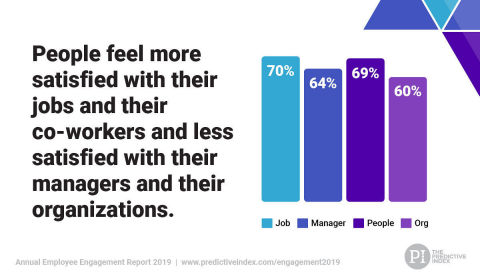BOSTON--(BUSINESS WIRE)--On average, actively disengaged employees in the U.S. cost businesses $483 billion to $605 billion each year in lost productivity. In fact, one American multinational consumer electronics retailer found that a .1% increase in engagement was worth $100,000 in annual value.
To uncover which factors had the greatest impact on employee engagement and turnover, The Predictive Index—the leader in talent optimization—asked 3,000+ employees why they really quit, and what makes them go the extra mile in The Annual Employee Engagement Report.
“While the report finds 71% of the country’s workforce is engaged, a closer look reveals people are more satisfied with their jobs and co-workers and less satisfied with their companies and managers,” said Daniel Muzquiz, President & Chairman of The Predictive Index.
“Addressing these talent optimization challenges is a massive opportunity for organizations. According to Towers Perrin, companies with engaged workers grew their earnings per share 28% over 12 months, while those with low engagement experienced an 11% decline. In short, companies that deliver on engagement get major financial returns…and their employees will go home happier.”
Key Findings
People enjoy their jobs, but are less satisfied with their company
3,000+ employees rated a list of more than 50 items spanning four categories: job, manager, people, and organization. About 70% of respondents enjoy their job, 69% like their co-workers, 64% feel favorably about their direct manager, and 60% are happy with their company.
Trust in a company’s future and C-Suite matter most when it comes to engagement
Nine of the top 10 engagement drivers involve the organization and its senior leaders (versus job, manager, or coworkers). Faith in the company’s future, trust in senior leadership, and the organization's level of investment in its people have the strongest impact.
People leave bad companies and senior leaders
Nine of the top 10 drivers of turnover also pertain to organizational matters. As was the case with engagement, whether people choose to stay or leave depends on their faith in the company’s future, its C-Suite, and its people investment.
Using people data can move the needle on engagement
Among companies that use assessments to hire, improve communication, and build teams see at least a 20% higher engagement score than those that do not use assessments. What’s more, employees who have access to their assessment results report 87% engagement versus 64% engagement among those who do not.
Company age isn’t just a number when it comes to engagement
Companies five years or younger reported engagement levels of 77% compared to 68% at companies 30 years and older—indicating that engagement dips slightly as companies mature.
Research Methodology
In February of 2019, The Predictive Index conducted a survey of executives, managers, and individual contributors across 20 different industries, securing 3,000+ responses. The survey asked respondents to rank items correlated with employee engagement across four categories—job, manager, people, organization—on a 5-point scale to uncover the state of engagement in the US.
A copy of the The Annual Employee Engagement Report for 2019, including charts, is available at: https://resources.predictiveindex.com/report/employee-engagement-report-full/
About The Predictive Index
The Predictive Index (PI) is an award-winning talent optimization platform that aligns business strategy with people strategy for optimal business results. Sixty years of proven science, software, and a robust curriculum of insightful management workshops make PI the solution for any company looking to design great teams and cultures, make objective hiring decisions, and inspire greatness in their people anywhere in the world. More than 7,000 clients use PI—including Nissan, Citizens Bank, DocuSign, Subway, 47 Brand, Blue Cross Blue Shield, and Omni Hotels—across 142+ countries. Learn more at http://www.predictiveindex.com/.

